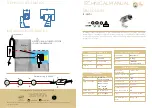
PROLED
WALLWASHER XL RGBW DMX
www.proled.com
17
1. If you are using a controller with a 5 pin DMX output socket, you need a 5 pin to 3 pin
XLR adapter cable.
2. At the last unit the DMX output must be terminated with a terminator plug. Solder a 120
Ohm ¼ W resistor between pin 2 (DMX-) and pin 3 (DMX+) into a 3-pin XLR-plug and
insert it in the DMX output socket of the last unit.
3. Connect the units together in a daisy chain with XLR cables from the output of one unit
to the input of the next unit. The cable can not branched or split to a `Y` cable. DMX
512 is a very high speed signal. Inadequate or damaged cables, soldered joints or
corroded connectors can easily distort the signal and shut down the system.
4. The DMX output and input connectors are pass-through to maintain the DMX circuit,
when one of the units’ power is disconnected.
5. Each lighting unit needs to have a preconfigured address to receive the data sent by
the controller. The address number is between 0-511 (usually 0 & 1 are equal to 1).
6. The end of the DMX 512 link should be terminated to reduce signal errors.
7. 3 pin XLR connectors are more popular than 5 pin XLR.
8. 3 pin XLR: pin 1: GND, pin 2: negative signal (-), pin 3: positive signal (+)
9. 5 pin XLR: pin 1: GND, pin 2: negative signal (-), pin 3: positive signal (+), pin 4 / pin 5:
not used.
6. Troubleshooting
In the following a few common problems are described, that may occur during
operation. Here are some suggestions for an easy troubleshooting:
A. The unit is not operating, no light is generated and the fan does not work
1. Check the connection of power and main fuse.
2.
Check the mains voltage on the main connector
.
B. The unit is not responding to the DMX controller
1. The DMX LED should be on. If not, check the DMX connectors and cables to see if the
link is properly set up.
2. If the DMX LED is on and the unit does not respond to the control channel, check the
address settings and the DMX polarity.
3. If you have intermittent DMX signal problems, check the pins on connectors or on PCB
of the particular unit or the previous one.
4. Try to use another DMX controller.
5. Check if the DMX cables are installed near or parallel to high voltage cables. Strong
electromagnetic fields, as produced from high voltage cables may cause damage or
interference to the DMX interface circuit.


































